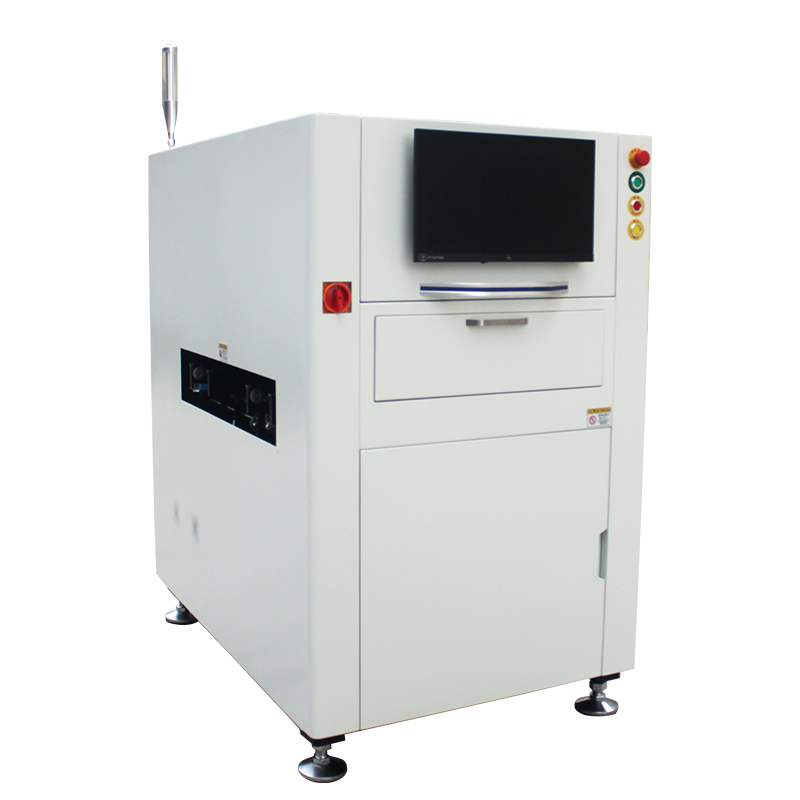Email format error
Email cannot be empty
Email already exists
6-20 characters(letters plus numbers only)
The password is inconsistent
Email format error
Email cannot be empty
Email does not exist
6-20 characters(letters plus numbers only)
The password is inconsistent


Revolutionizing Quality Control with AOI Automatic Inspection Machines
In today's fast-paced manufacturing landscape, ensuring product quality is paramount. One technology that has revolutionized quality control processes is the AOI (Automated Optical Inspection) machine. With its ability to detect defects and anomalies with precision and speed, AOI machines have become indispensable in various industries. In this blog post, we'll delve deep into the workings of AOI automatic inspection machines, exploring their capabilities, applications, and impact on manufacturing excellence.
Understanding AOI Automatic Inspection Machines
The Evolution of Inspection Technology
The journey from manual inspection processes fraught with human error to the automated precision of AOI machines represents a significant evolution in quality control technology. Previously, inspectors relied solely on visual inspection, which was not only time-consuming but also prone to errors. The introduction of AOI machines has transformed this landscape by leveraging advanced optics and algorithms to achieve unparalleled accuracy and efficiency.
How AOI Automatic Inspection Machines Work
At the core of an AOI machine lies a sophisticated combination of optical systems and computational algorithms. These systems work in tandem to capture high-resolution images of components or products under inspection and analyze them in real-time for defects or deviations from specifications. The process begins with the placement of the item to be inspected on the machine's conveyor belt or inspection platform. As the item moves through the inspection area, multiple high-resolution cameras capture detailed images from various angles. These images are then processed by the machine's software, which applies complex algorithms to detect defects such as missing components, misalignments, soldering issues, or surface anomalies. The inspection results are then presented to the operator for review and action, ensuring that only products meeting quality standards proceed further along the production line.
Key Components of AOI Automatic Inspection Machines
● High-resolution cameras: AOI machines are equipped with multiple high-resolution cameras strategically positioned to capture detailed images of the components or products under inspection. These cameras utilize advanced imaging technologies such as CCD (Charge-Coupled Device) or CMOS (Complementary Metal-Oxide-Semiconductor) sensors to achieve exceptional image quality and clarity.
● Lighting systems: Various lighting techniques, including diffused lighting, dark-field illumination, and backlighting, are employed to enhance the visibility of different features and defects on the inspected items. Proper lighting is essential for highlighting surface irregularities, solder joints, and other critical details for accurate defect detection.
● Image processing algorithms: The captured images are subjected to rigorous analysis by sophisticated image processing algorithms. These algorithms are designed to identify patterns, anomalies, and defects based on predefined criteria and tolerances. Machine learning and artificial intelligence techniques are increasingly being integrated into AOI systems to improve defect detection accuracy and adaptability to new inspection challenges.
● Inspection software: Intuitive software interfaces provide operators with the tools to configure inspection parameters, define defect criteria, and analyze inspection results. The software allows for customization of inspection routines to accommodate varying product designs, specifications, and quality standards. Advanced features such as 3D inspection, color analysis, and defect classification further enhance the capabilities of AOI machines in detecting subtle defects and ensuring product quality.
Applications of AOI Automatic Inspection Machines
Electronics Manufacturing
In the electronics manufacturing industry, where miniaturization and complexity are increasing at a rapid pace, AOI machines play a crucial role in ensuring the quality and reliability of electronic components and assemblies. Printed Circuit Boards (PCBs), surface-mount devices (SMDs), and other electronic assemblies undergo comprehensive inspection to detect defects such as soldering defects, bridging, tombstoning, lifted leads, and component misplacements. AOI machines are capable of inspecting both visible and hidden solder joints, including through-hole vias and ball grid arrays (BGAs), with high accuracy and repeatability. By identifying defects early in the production process, AOI machines help prevent costly rework, scrap, and field failures, thereby improving overall product yield and customer satisfaction.
Automotive Industry
In the automotive industry, where safety and reliability are paramount, AOI machines are employed to inspect critical components and subsystems used in vehicle manufacturing. Engine control modules (ECMs), transmission systems, wiring harnesses, sensors, and electronic control units (ECUs) undergo rigorous inspection to ensure compliance with stringent quality standards and regulatory requirements. AOI machines detect defects such as solder shorts, open circuits, component misalignments, and foreign object debris (FOD) that could compromise the performance, safety, and longevity of automotive systems. By identifying defects early in the production process, AOI machines help automotive manufacturers deliver vehicles that meet or exceed customer expectations for quality, reliability, and durability.
Pharmaceutical Manufacturing
In pharmaceutical manufacturing, where product integrity and patient safety are paramount concerns, AOI machines are utilized to inspect various dosage forms, including tablets, capsules, vials, and syringes. AOI inspection ensures that pharmaceutical products are free from defects such as cracks, chips, scratches, stains, and contamination that could compromise their efficacy, stability, or sterility. By adhering to strict quality control standards and regulatory guidelines, pharmaceutical manufacturers can mitigate the risks associated with defective products and safeguard public health. AOI machines equipped with advanced imaging technologies, spectral analysis, and machine learning algorithms enable pharmaceutical companies to achieve consistently high levels of product quality and compliance with regulatory requirements.
Advantages of AOI Automatic Inspection Machines
Enhanced Accuracy
One of the primary advantages of AOI machines is their unparalleled accuracy in defect detection. Unlike human inspectors, who may overlook subtle defects or inconsistencies, AOI machines employ advanced imaging technologies and image processing algorithms to detect defects with micron-level precision. By analyzing multiple images from different perspectives and lighting conditions, AOI machines can identify defects that may be imperceptible to the human eye, ensuring thorough and reliable inspection of components and products.
Increased Productivity
By automating the inspection process, AOI machines significantly enhance productivity on the manufacturing line. Unlike manual inspection methods, which are inherently slow and labor-intensive, AOI machines can inspect components or products at high speeds without compromising accuracy or repeatability. With the ability to perform continuous, non-stop inspection operations, AOI machines minimize production bottlenecks, reduce cycle times, and increase overall throughput. As a result, manufacturers can achieve higher levels of efficiency, capacity utilization, and production output while maintaining stringent quality control standards.
Cost Savings
While the initial investment in AOI machines may represent a significant capital expenditure for manufacturers, the long-term cost savings they offer are substantial. By reducing the need for manual inspection labor and minimizing the occurrence of defects, rework, and scrap, AOI machines deliver a high return on investment over their operational lifespan. Furthermore, AOI machines help manufacturers avoid costly product recalls, warranty claims, and customer returns by ensuring that only high-quality, defect-free products are released to the market. By optimizing production processes, minimizing waste, and maximizing product quality, AOI machines contribute to improved profitability, competitiveness, and customer satisfaction for manufacturers across various industries.
Challenges and Considerations
Complexity of Programming
While AOI machines offer unparalleled precision and versatility in defect detection, programming them to effectively inspect diverse products can be challenging. Manufacturers must invest time and resources in developing and optimizing inspection programs tailored to their specific product designs, materials, and manufacturing processes. The complexity of programming AOI machines increases with the variability and complexity of the products being inspected, requiring expertise in optics, imaging, algorithms, and quality control methodologies. Additionally, ongoing maintenance and calibration of AOI systems are essential to ensure their continued reliability, accuracy, and performance over time.
Integration with Existing Systems
Integrating AOI machines into existing manufacturing systems and workflows can present logistical and technical challenges, particularly in legacy production environments. Manufacturers must ensure seamless communication and data exchange between AOI machines and other automated systems such as robotic assembly lines, pick-and-place machines, and quality management software. Compatibility issues, data format differences, and interoperability constraints may arise when integrating AOI machines with legacy equipment or proprietary software platforms. To maximize the benefits of AOI technology, manufacturers may need to invest in system integration services, software development, and training to optimize the performance and efficiency of their automated inspection systems.
Future Trends in AOI Technology
AI-Powered Inspection
The integration of artificial intelligence (AI) algorithms into AOI machines represents a significant advancement in quality control technology. AI-powered inspection systems leverage machine learning, pattern recognition, and predictive analytics to enhance defect detection accuracy, speed, and adaptability. By analyzing vast amounts of inspection data and learning from past inspection results, AI algorithms can identify complex patterns, anomalies, and trends that may indicate potential defects or process deviations. Furthermore, AI-powered AOI systems can self-optimize their inspection routines, adjusting parameters dynamically based on real-time feedback and performance metrics. As AI technology continues to evolve, AOI machines equipped with AI algorithms will become increasingly intelligent, autonomous, and capable of delivering even higher levels of accuracy and efficiency in quality control applications.
Industry 4.0 Integration
As manufacturing evolves towards Industry 4.0 principles of connectivity, automation, and data-driven decision-making, AOI machines will play a central role in smart factories of the future. Integration with Internet of Things (IoT) devices, cloud-based analytics platforms, and digital twins will enable real-time monitoring, analysis, and optimization of quality control processes. AOI machines equipped with IoT sensors can collect and transmit data on machine performance, product quality, and environmental conditions to centralized control systems for analysis and action. Predictive maintenance algorithms can anticipate equipment failures, prevent downtime, and optimize inspection schedules based on usage patterns and wear indicators. By harnessing the power of big data, artificial intelligence, and connectivity, manufacturers can achieve unprecedented levels of productivity, efficiency, and quality assurance across their operations.
Conclusion
In conclusion, AOI automatic inspection machines represent a paradigm shift in quality control across various industries, from electronics manufacturing to automotive production to pharmaceuticals. With their unparalleled accuracy, speed, and efficiency, AOI machines are indispensable tools for ensuring product quality, enhancing productivity, and driving cost savings. By leveraging advanced optics, imaging algorithms, and automation technologies, AOI machines enable manufacturers to detect defects with micron-level precision, minimize production bottlenecks, and optimize resource utilization. As technology continues to evolve, the future of AOI machines promises even greater advancements in quality control, manufacturing excellence, and Industry 4.0 integration. By embracing innovation and investing in AOI technology, manufacturers can stay ahead of the competition, deliver superior products to market, and meet the demands of increasingly discerning customers.

